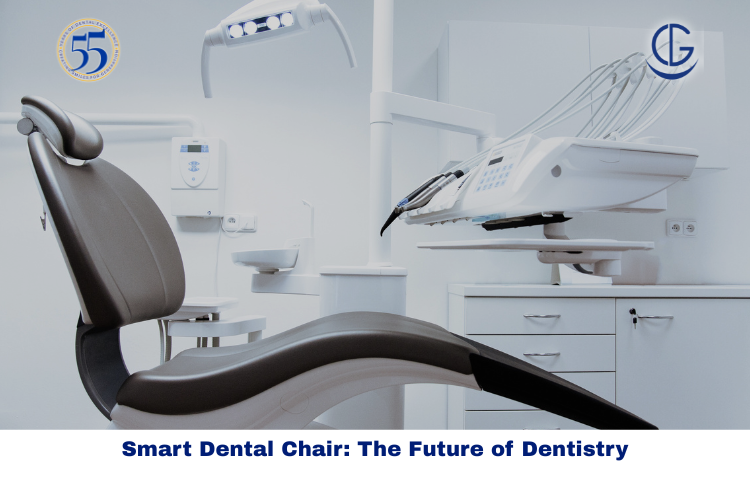Schedule Appointment




What is a dental chair? At Dr. Gowds Dental Hospital, we believe a dental chair is more than furniture—it’s the starting point for high-quality patient care. Today’s IoT-Connected Dental Chairs & Smart Equipment use technology to improve patient comfort, increase safety, and help dental teams work more efficiently. These innovations are turning traditional clinics into smart clinics—designed for precision, hygiene, and seamless digital integration.
Smart dental chairs are equipped with sensors, software, connectivity, and automation. They do more than move—they interact with other devices, remember patient settings, and automate processes. When a patient walks into the room, the chair can adjust automatically to the saved settings from their last visit. For dentists, that means less manual setup and more focus on treatment. Integrated smart lighting, posture alignment, and connectivity with diagnostic tools make these chairs the digital heart of a modern dental operatory.
Patient comfort is no longer a luxury—it’s a necessity. IoT-connected dental chairs provide pressure-sensitive memory foam, automatic lumbar support, and calming tilt transitions. Integrated screens and audio allow dentists to explain procedures in real-time or play soothing content for anxious patients. The automation reduces chair-time and improves the overall patient experience by eliminating discomfort and making treatment sessions feel faster and more relaxed.
In clinics like Dr. Gowd’s, where patient-centered care is the priority, these features help retain long-term patients who appreciate consistency and care.
For dental professionals, smart equipment is a game-changer. From pre-op to cleanup, IoT chairs can automate positioning for various procedures. They integrate with patient management software to pull up records instantly, helping dentists and hygienists save time and reduce errors.
Advanced chairs also come with foot pedals or mobile apps that allow control without touching traditional buttons—great for infection control. The smart design enhances ergonomics, reducing physical strain on dentists and assistants, while customizable settings support multiple practitioners in one room.
One major benefit of IoT-Connected Dental Chairs & Smart Equipment is predictive maintenance. Built-in sensors monitor the condition of parts—like electric motors, upholstery, control panels, and light arms—and notify the clinic before anything breaks.
This allows dental offices to plan maintenance without unexpected breakdowns. Technicians receive alerts on usage cycles and can schedule service or replacements in advance, reducing operational costs and preventing lost appointments.
Hygiene has always been a priority in dental care, but COVID-19 raised the bar. Smart equipment supports stricter safety protocols with features like auto-disinfecting water lines, hands-free controls, self-cleaning spittoons, and UV light-based sterilization.
Additionally, some chairs are equipped with sensors to track the frequency of cleanings and usage, creating digital hygiene logs. This helps clinics stay compliant and provide patients with visible, verifiable safety standards—something that builds trust and reputation.
A truly connected clinic doesn’t just stop at the chair. IoT integration includes everything from dental lasers to imaging systems. Chairs can sync with panoramic X-rays, intraoral cameras, and cloud-based patient records.
Imagine a situation where the dental light auto-adjusts based on the shade of tooth being worked on, or a chair reclines precisely based on the procedure being initiated from a digital treatment plan. These small efficiencies add up to significantly smoother and faster treatments.
At Dr. Gowd’s Dental Hospital, our integrated smart systems have improved productivity by reducing transition times between patients and procedures.
Smart dental chairs are designed with technology and comfort in mind. Key components include:
These parts work together to improve dentist workflow and patient comfort while promoting safer treatment environments.
Dr. Gowds Dental Hospital has been at the forefront of adopting IoT-Connected Dental Chairs & Smart Equipment. With multiple operatories equipped with smart units, our clinic benefits from centralized patient data, real-time chair adjustments, safer sterilization, and more confident decision-making.
The result? Faster appointments, fewer rescheduled due to maintenance, and happier patients who notice and appreciate the difference
By now you likely know that IoT-Connected Dental Chairs & Smart Equipment are radically changing how care is delivered, and making patients more comfortable and making dentists more productive. These technologies can take dental practices to a competitive and relevant space once more with a more future-ready, modern practice.
At Dr. Gowd’s Dental Hospital we adopted smart technology not to be on the cutting-edge or for the sake of being trendy, but because we believe in the technology and most importantly, the power of using it to elevate care and enable us to create better experiences that builds stronger relationships with our patients. If your clinic wants to be competitive, smart dental chairs are not a luxury but rather a necessity.
1. What is a dental chair?
A dental chair is a chair designed specifically for patients to sit in during dental work. Smart chairs have sensors and software to provide greater comfort and improve dentists’ ability to work.
Dental equipment means all of the various tools and devices used by dentists – for example, dental chair, drills, lights, suction devices, X-ray machines and sterilization devices.
A dental chair is for the patient to sit in, while a dental unit is the part that includes things like water sprays, suction, and instrument trays. The dental chair and the dental unit make a complete treatment station.
It enhances comfort, automatically adapts to the patient, stores patient preferences, and connects to other devices through the cloud, making treatment faster and safer.
No, smart dental chairs are less difficult to maintain because they monitor themselves and send alerts when something needs attention. There are fewer surprises when trying to avoid breakdowns.